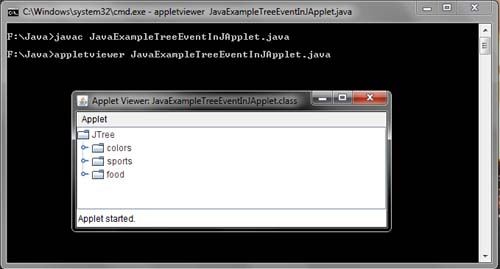Using a JTree is as simple as saying:
add(new JTree( new Object[] {“One”, “Two”, “Three”}));
This displays a primitive tree. The API is huge tree without But, certainly one of the longest of Swing. It seems that you can do everything with trees, but the most sophisticated tasks may require quite a bit of research and experimentation.
import java.awt.*;
import javax.swing.*;
import java.awt.event.*;
import javax.swing.tree.*;
public class JavaExampleTreeEventInJApplet extends JApplet
{
public void init()
{
JTree Tree = new JTree();
getContentPane().add(new JScrollPane(Tree));
Tree.addMouseListener(new MouseAdapter()
{
public void mousePressed(MouseEvent e1)
{
String OutStrng = null;
JTree Tree=(JTree)e1.getSource();
int ClckdRow = Tree.getRowForLocation(e1.getX(), e1.getY());
if(ClckdRow != -1)
{
TreePath TreePth = Tree.getPathForRow(ClckdRow);
TreeNode TreeNd = (TreeNode)TreePth.getLastPathComponent();
OutStrng = "Node " + TreeNd.toString();
if(e1.getClickCount() == 1)
{
OutStrng += "Clicked Single.";
}
else
{
OutStrng += "Clicked Double.";
}
showStatus(OutStrng);
}
}
});
}
}
/*<APPLET CODE =JavaExampleTreeEventInJApplet.class WIDTH = 35 HEIGHT = 280 ></APPLET>*/

 Dinesh Thakur holds an B.C.A, MCDBA, MCSD certifications. Dinesh authors the hugely popular
Dinesh Thakur holds an B.C.A, MCDBA, MCSD certifications. Dinesh authors the hugely popular